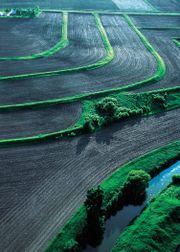
Terraces, conservation tillage, and conservation buffers save soil and improve water quality on this Iowa farm. 1999. Photo by Lynn Betts, USDA Natural Resources Conservation Service.
Erosion control is the practice of preventing or controlling wind or water erosion in agriculture, land development and construction. Effective erosion controls are important techniques in preventing water pollution and soil loss.
Introduction[]
Erosion controls are used in natural areas, agricultural settings or urban environments. In urban areas erosion controls are often part of stormwater runoff management programs required by local governments. The controls often involve the creation of a physical barrier, such as vegetation or rock, to absorb some of the energy of the wind or water that is causing the erosion. On construction sites they are often implemented in conjunction with sediment controls such as sediment basins and silt fences.
Examples[]
Examples of erosion control methods include:
|
Mathematical modeling[]
Since the 1920s and 1930s[3] scientists have been creating mathematical models for understanding the mechanisms of soil erosion and resulting sediment surface runoff, including an early paper by Albert Einstein applying Baer's law.[4] These models have addressed both gully and sheet erosion. Earliest models were a simple set of linked equations which could be employed by manual calculation. By the 1970s the models had expanded to complex computer models addressing nonpoint source pollution with thousands of lines of computer code.[5] The more complex models were able to address nuances in micrometerology, soil particle size distributions and micro-terrain variation.
See also[]

Hydroseeding in UK
- Bridge scour
- Burned area emergency response
- Certified Professional in Erosion and Sediment Control
- Coastal management
- Dust Bowl
- Natural Resources Conservation Service (United States)
- Universal Soil Loss Equation
- Vetiver
References[]
- Albert Einstein. 1926. Die Ursache der Mäanderbildung der Flußläufe und des sogenannten Baerschen Gesetzes, Die Naturwissenschaften, 11, S. 223–224
- C. Michael Hogan, Leda Patmore, Gary Latshaw, Harry Seidman et al. 1973. Computer modeling of pesticide transport in soil for five instrumented watersheds, U.S. Environmental Protection Agency Southeast Water laboratory, Athens, Ga. by ESL Inc., Sunnyvale, California
- Robert E. Horton. 1933. The Horton Papers
- U.S. Natural Resources Conservation Service (NRCS). Washington, DC. "National Conservation Practice Standards." National Handbook of Conservation Practices. Accessed 2009-03-28.
Line notes[]
- ↑ State of California Department of Transportation, Division of Environmental Analysis, Stormwater Program. Sacramento, CA."Cellular Confinement System Research." 2006.
- ↑ Tennessee Department of Environment and Conservation. Nashville, TN."Tennessee Erosion and Sediment Control Handbook." 2002.
- ↑ Robert E. Horton. 1933
- ↑ Albert Einstein. 1926
- ↑ C. Michael Hogan, Leda Patmore, Gary Latshaw, Harry Seidman et al. 1973
External links[]
- Erosion Control - a trade magazine for the erosion control industry
- International Erosion Control Association - Professional Association, Publications, Training
- ESCN.tv - Erosion and Sediment Control Network - Online TV show dedicated to Erosion and Sediment Control Industry with archives and video library
- WatchYourDirt.com - Erosion Control Educational Video Resource
- Soil Bioengineering and Biotechnical Slope Stabilization - Erosion Control subsection of a website on Riparian Habitat Restoration
- Vetiver Network International - Soil and water management method